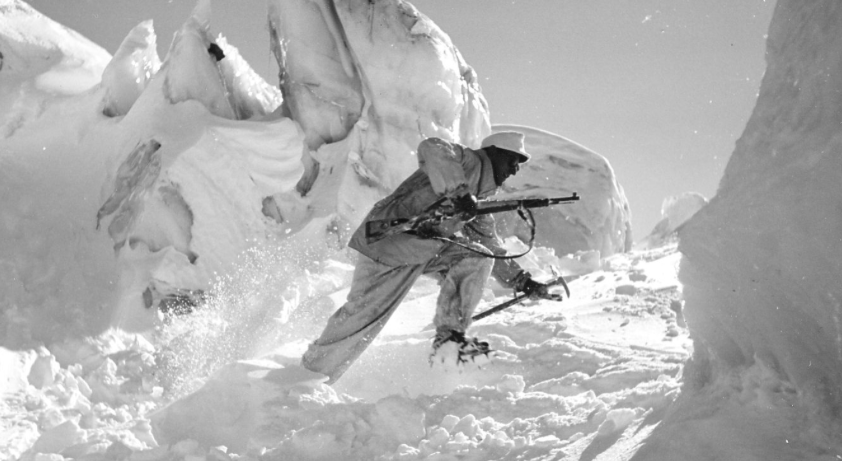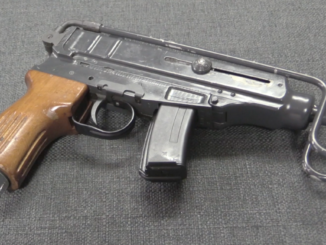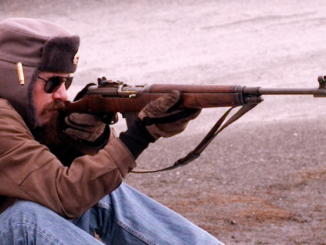Having gained independence after World War One, Czechoslovakia looked to standardize and improve its armaments. Václav Holek went to work for the Zbrojovka Praga factory in Prague in 1918, and they introduced the Model 1919 pistol the next year. It was purchased by both Czech military and police forces, as well as selling commercially. The Army bought 5,000 in 1919 and another 4,600 in 1921. Early models have a script slide legend, which changed to block letters later in production. Some also have large lanyard loops.
Mechanically, the gun is a simple blowback .32 ACP (7.65mm Browning). It uses a shrouded hammer to fire, and has a couple neat mechanical features. The recoil spring is nicely contained for disassembly, and the breechblock drops free for easy assembly or maintenance. However, the Praga factory was poorly managed, and went bankrupt in 1926. Holek would move to the Brno factory and perfect his machine gun design (the ZB-26), and the Czech army would make a more complete rearmament with the vz.22 pistol developed from Josef Nickl’s work at Mauser.
Sold for $3,450 (paired with a CZ Model 1936) at the December 2019 RIA Premier auction.




Thank for showing this item of collector’s curiosity. On first glance it look like trendy model 1900 FN Browning.
I have to command Ian for trying hard to say correctly some Czech words, however first name “Vaclav” is pronounced more like “va-ts-lav”. I suppose the least important detail, but still.
“(…)Czech words(…)”
Why it was called Zbrojovka Praga rather than Praha, with that first being Deutsch word if I am not mistaken?
You might be right, to some degree, but you may know Praha in Deutsch is Prag, not Praga. For curiosity – Praga in name of part of Warszawa, Poland, so it has broader Slavic base.
Name Praga was resurected after the war as a major maker of trucks/ lorries.
Indeed in Deutsch it is Prag.
“(…)Praga in name of part of Warszawa, Poland, so it has broader Slavic base.(…)”
In Polish language Czech capital is also called Praga. ISO-9 compliant transliteration of Russian Прага also result in Praga. Praga was also seemingly used in Latin.
https://www.quora.com/How-did-Praha-the-capital-city-of-the-Czech-Republics-name-get-to-be-spelled-and-known-as-Prague-in-the-United-States
True, there is affinity between Poles and Czechs (and likely same with Slovaks). When I visited Poland with my parents in mid 60s, we were able to converse in our original languages. There is ongoing spirit of friendship between both nations.
I could only say that: https://funnyjunk.com/Western+slavs+vs+eastern+slavs+vs+southern+slavs/dNytLqA/
I thought that Zbrojovka Praha was transferred into Zbrojovka Brno including first machineguns development and people behind the development. So it was not that the former was out-competed by latter. Maybe Ian says just that but I do not get it right.
Zbrojovka Strakonice (South-Czech weapon factory) stayed in place till late 1950s however (they were originators of pistol vz.52 and rifle of the same name). Later re-oriented their program into motorcycles production, under same name.
The current CZUB was initiated by part thru government effort as new outfit in early 1930s.
“(…)“Vaclav”(…)”
If anyone caries about that anglicized form seems to be Wenceslaus taking in account one of dukes of Bohemia: https://en.wikipedia.org/wiki/Wenceslaus_I,_Duke_of_Bohemia
You are correct. First with that name was duke Vaclav (later declared Saint and patron of Bohemia), continued with kings Vaclav II and III and eventually last – Vaclav IV. Those first three were Premyslovites, the last one was in part Luxmbourg – after his father, Roman emperor Karel IV who’s father was Jean Luxembourg.
Vaclav II was king of great significance and connection to Polish throne. https://cs.wikipedia.org/wiki/V%C3%A1clav_II.
“(…)spring(…)”
Cut-away drawing can be seen here (3rd image from top, click to enlarge):
http://www.vhu.cz/pistole-praga/
This automatic pistol is patented – Czechoslovak patent number 1328 year 1921.
Article states that in late 1921, situation become urgent as in answer to Karl Habsburg (in full form : Karl Franz Josef Ludwig Hubert Georg Maria) return to Hungary and attempt of assuming power, Czechoslovak forces start mobilizing. Zbrojovka Praga had 4600 examples of these pistol and all were instantly bought with price of 460 Kč per example for 2 116 000 Kč total. [I am not sure if it can be converted to other currency of that era – was Kč bound to gold value in 1921?]. Due to hurrying quality control was quite loose and thus many poorly working examples passed. It caused bad reputation in armed forces of Czechoslovakia. In 1924 year 474 examples were returned for refurbishment. Production would continue until 1923 with total of 11 200 examples.
As for Karl Franz Josef Ludwig Hubert Georg Maria his attempt proved failure due to action of Horthy Miklós who would rule Kingdom of Hungary well into Second World War (known for leading to situation where Kingdom has no king, boss is titled Great Admiral but there is not access to sea, allies Romania attack Soviet Union, even though has territorial claims against former but not later).
During times I lived in my first country I had one excellent book (unfortunately it was lost in process) which described in detail acquisition of small arms by government of CSR during pre-Munich republic. My impression was that Zbrojovka Praga was gauging government. It may have been wrong grasp of reality, but that is how I felt at that time. I did not know much that time what were circumstances of running a successful business.
On general note – the economy of First republic (1918-38) was marked by great fiscal austerity. Prices were nominally low but so were earnings. There was widespread unemployment and often cases of outright misery which gave space for foundation of Communist party in 1921. If Czech Crown was based on gold I cannot confirm but it is known that state bullion was substantial, later looted by Nazis.
Btw., looking at that section drawing form VHU page I can tell that the curve of back-strap could have been made deeper for easier grasp. It is easy to critique, but in general I do not like long/ shallow backstrap grips. Such is the case among others with TT33, but in that case there is justifiable reason for it.
I think, the backstrap was so shaped to point the unsimilarity with the popular FN 1910.
Miklos Horthy used the title admiral because he was a rear admiral in the KuK Kriegsmarine before the Austro-Hungarian Empire broke up. He had an active career in WWI and ended the war a C in C.
Though looking crude, this gun carries unique features like; stational disconnector upper tip transmitting camming force of slide at its minimum movement to trigger at whatever position it has, direct blocking hammer providing positive safety at unworn state of hammer and safety, removable breechblock providing close tolerances for barrel taken out… Bad feature is the hidden, inside extractor creating a hard job to exract a live round in case of its sticking inside the chamber… Over all, a successfull working over a known design. lMHO…
With some improvements in areas you mention, it could have been a base for larger pistol in 9mm Browning instead of conceptually questionable and complex vz.22/24 pistols.
In Handguns of the World, Ezell states that the government wanted the army to buy the Praga (which he calls the Vz.21) instead of the Vz.22/24 on the grounds that the Praga was considerably less expensive.
The army wanted the Vz.22/24 because it was more accurate and had less recoil. Also, I personally suspect they found its grip more comfortable.
Also keep in mind that originally the Vz.22, with its rotating-barrel lock, was to have been a 9 x 19mm, but in the end, it was produced in 9mm Kurz (.380 ACP). Finally, the later Vz.27 kept the outline of the Vz.22/24, but was built in 7.65mm Browning (.32 ACP), and deleted the locking system entirely, becoming a straight-blowback.
In other words, what they ended up with was pretty much a Praga with a different-shaped grip.
cheers
eon
Really? Those rotary actions have something about them why users like them.
Users like them, government budgeters don’t. They cost more.
cheers
eon
Local store had a used pistol for sale. Price tag said it was Zasta Model 70, caliber NA. Clerk said it was from Czechoslovakia. It was Zastava in 7.65. Name was worn to just first 5 letters. Caliber clearly marked on slide. Clerk said no one knew what that caliber was. Asking $209.
Sad fact, it was local gun department of Gander Outdoors.
That yugo attempt of first time inventing a pistol (among other arms being copies of everything, SKS, k98, AK, mg42 etc.) has a not so great reputation, realistic price would be like 80$.
Lack of history and geography knowledge with common North Americans is amusing. When I was picking my vz.52 pistol at local police HQ (where seller sent it) the officer told me: “but, they need them at home, don’t they ?”.
He was obviously referring to war/ breakup of Yugoslavia in 1990s. He obviously never heard of “velvet revolution”, not to mention he did not bother to look at marking. This is what one time (actually already ending) comfortable life on this continent resulted into. Interest in sports took priority over general knowledge.
Does the pistol have a generally accepted English name?
Really dumb question: how much demand was there for .32 ACP, since lots of Ruby pistols (amongst plenty of other Great War pocket guns) were sold off as military surplus?
My understanding is that .32 ACP was very popular in Europe til end of WW2. Used my police and military. Still more popular in Europe than North America. Not really sure why as many fine pistols were offered in this caliber.
Any pistol cartridge with a projectile diameter greater than 8 mm or so was considered “military grade,” even 9×17 Browning (AKA .380 ACP). Civilians were prevented from owning pistols in 9mm caliber (which was restricted to Army usage), so you do the math…
But 7.65 was hugely popular with military and police.
I brought this up because after seeing this in the store, the above post was the first thing on firing up the computer. Curious coincidence. I have no interest in value/condition as I have zero intent of acquiring it. I mentioned it as a sad comment on the gun department. They use to employ 2 pretty damn good gunsmiths and had a workshop right in the store. Now, the 4 or 5 employees don’t even know what 7.65 is – or apparently how to look it up.
“(…)Not really sure why as many fine pistols were offered in this caliber.(…)”
I suspect national pride. This might have specially great effect in Czechoslovakia, after it become independent in 1918 year.
The PRAGA factory was located south of the city center in what is city district 10 today.
Praga is the Latin version of the city name and for example used in its great seal, which displays: PRAGA CAPUT REI PUBLICAE
The .32 ACP/ 7.65mm caliber was common all across old continent before WWI, between wars and after. Many thousands were made in major industrial countries. In CSR and later CSSR in particular, this trend was continued with police issue pistols CZ50/ CZ70.
They look externally similar with Walther PP but their mechanism is not the same. I had opportunity to examine in detail including partial dis-assembly of PP and complete dis-assembly of CZ70 and have documented it in pictures. Unfortunately I do not know how to attach them here. It might be interesting for some readers.
“(…) trend was continued with police issue pistols CZ50/ CZ70.(…)”
In 1950s convertible (I hope this is right word here) automatic pistol was developed in Polish People Republic by Piotr Wilniewczyc (you might known him for PM-63 xor P35(p) known in U.S. collectors parlance as RADOM) which was named WiR wz. 1957, sadly I could only link with text in Polish language, so it will be useless for you, but at least there are images: from top-left, clock-wise: general view, field strip, cut-away drawing:
http://bcpw.bg.pw.edu.pl/Content/5888/Wilniewczyc_9.pdf
it was designed to fire 7,65 mm Browning or 9×17 mm Kurz with conversion requiring only swapping barrels. Later 9 mm Makarov version was developed. Prototype was made, no production commenced [CZAK automatic pistol won – known in U.S. collectors parlance as “P-64”].
source: plate is from exposition titled exceptional gun designers of Politechnika Warszawska http://bcpw.bg.pw.edu.pl/dlibra/publication?id=6054&from=&dirids=1&tab=1&lp=1&QI=70341FD5744826FE85E317AA285D1E82-17
If you are wondering why they choose to use 7,65 mm Browning and 9×17 mm Kurz instead of using 9×18 mm Makarov from onset, it seems that in this time Makarov cartridge was still kept secret by Soviet Union.
On subject of “culture” of various productions in Balkan countries, as some readers allude to, I’d say that much – it varies in time and place of origin. Some earlier production looks indeed “cheesy” but that has changed since. You cannot compare vintage Yugo pistols with current trends.
Some armories like Zastava (Serbia) or Arsenal and later Arcus (Bulgaria) produce fine weapons in latest configuration. The difference in comparison with western renown brands is price tag.
https://en.wikipedia.org/wiki/Zastava_CZ_99
https://seenews.com/news/bulgarian-arms-maker-arcus-boosts-2018-net-profit-657230
It should be made clear that the “out-of-battery safety” is also the disconnector. Nice doubling up of functions.
.32/7.65 can still kill you, cripple you, condemn you to a horrible death from sepsis or peritonitis. Back when people were on average smaller, medical care was less effective, and motor ambulances rare, any bullet was fearsome and probably effective. Modern standards are not appropriate.
Great review!